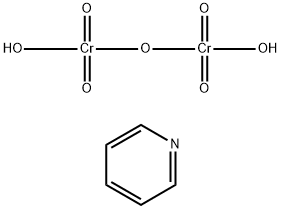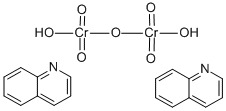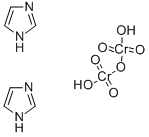Ammonium dichromate
Synonym(s):Ammonium bichromate;Ammonium dichromate
- CAS NO.:7789-09-5
- Empirical Formula: Cr2H8N2O7
- Molecular Weight: 252.06
- MDL number: MFCD00010879
- EINECS: 232-143-1
- SAFETY DATA SHEET (SDS)
- Update Date: 2025-09-25 17:15:13

What is Ammonium dichromate?
Chemical properties
bright orange-red crystals
Chemical properties
Ammonium dichromate is a combustible, orange-red crystalline solid which is used in solution.
Occurrence
Bright orange-red monoclinic crystals; odorless; hygroscopic; decomposes at 180°C; density 2.115 g/cm3 at 25°C; readily dissolves in water (26.67 g/100 g at 20°C).
The Uses of Ammonium dichromate
Ammonium dichromate is used in photo engraving, dye mordant, pigments, pickling, photography, process engraving, lithography, pyrotechnics, glazes for porcelain and china wares. It acts as a catalyst and a source of nitrogen in the laboratory and as the photoactive site. It is also used in the preparation of alizarin and chrome alum. Further, it is used in leather and oil industry for tanning and purification respectively. It is involved in the production of the phosphor raster television screens and other devices.
The Uses of Ammonium dichromate
It is used in oxidimetric standard.
The Uses of Ammonium dichromate
Source of pure nitrogen (esp in the laboratory); in pyrotechnics (Vesuvius fire); in lithography and photo engraving; in special mordant, catalysts, and porcelain finishes; intermediate in the manufacture of pigments; of magnetic recording materials.
The Uses of Ammonium dichromate
Yellow needles made by chromic acid acting on ammonium hydroxide. The product is produced by crystallization. Ammonium dichromate was used interchangeably with potassium dichromate for sensitizing gelatin, albumen, gums, and other colloids that were used for pigment processes. Ammonium dichromate is more sensitive than the potassium alternative.
What are the applications of Application
Ammonium dichromate is a dichromate salt oxidant for reactions with reducing agents
General Description
Ammonium dichromate is a bright orange red crystalline solid. Ammonium dichromate is readily ignited and burns producing a voluminous green residue. If heated in a closed container, the container may rupture due to the decomposition of the material. Ammonium dichromate may also act as a strong oxidizing agent if mixed with or contaminated with combustible material. Ammonium dichromate is soluble in water.
Air & Water Reactions
Water soluble.
Reactivity Profile
Ammonium dichromate is an oxidizing reagent, Ammonium dichromate readily reacts with reducing materials, in large quantity Ammonium dichromate may produce a violent reaction. Direct exposure to heat or shock will explode it. When heated to decomposition Ammonium dichromate emits toxic fumes of ammonia and nitrogen oxides [Sax, 9th ed., 1996, p. 205].
Hazard
Dusts and solutions are toxic, irritating to eyes and skin; dangerous fire risk. Strong oxidizing agent may explode in contact with organic materi- als. TLV: 0.05 mg(Cr)/m 3 ; Confirmed human car- cinogen.
Health Hazard
Inhalation causes irritation or ulceration of the mucous membranes of the nose, throat or respiratory tract. Respiratory irritation can produce symptoms resembling those of asthma. Continuing irritation of the nose may lead to perforation of the nasal septum. External contact can cause eye irritation and conjunctivitis, irritation and ulceration of skin wounds, and rash or external ulcers. If ingested, irritates mucous membrane and causes vomiting.
Safety Profile
Confirmed human carcinogen. Poison by inhalation, ingestion, skin contact, and subcutaneous routes. See also CHROMIUM COMPOUNDS. An unstable oxidizer. Moderately flammable; reacts with reducing agents.
Potential Exposure
It is used in dyeing, leather tanning and to make fireworks and chromic oxide; in lithography and photoengraving; in manufacture of special mordants and catalysts.
Shipping
UN1439 Ammonium dichromate, Hazard Class: 5.1; Labels: 5.1-Oxidizer.
Purification Methods
It crystallises from weak aqueous HCl (ca 1mL/g). It decomposes rapidly on heating. (Possible carcinogen and is POISONOUS)
Incompatibilities
An unstable oxidizer; freezing/melting point5(decomposes below MP) 180 C; decomposition becomes self-sustaining and violent at about 225 C. Contact with combustible, organic or other easily oxidized materials, strong acids; hydrazine and other reducing agents; alcohols, sodium nitrite may cause fire and explosions.
Waste Disposal
Consult with environmental regulatory agencies for guidance on acceptable disposal practices. Generators of waste containing this contaminant (≥100 kg/mo) must conform with EPA regulations governing storage, transportation, treatment, and waste disposal. Add a large volume of a reductant solution (hypo, bisulfite or ferrous salt and acidify with sulfuric acid). Neutralize when reduction is complete and flush to sewer with large volume of water.
Properties of Ammonium dichromate
| Melting point: | 170 °C (dec.)(lit.) |
| Density | 2.150 |
| vapor density | 8.7 (vs air) |
| solubility | H2O: 1 M at 20 °C, clear, colorless |
| form | Solid |
| color | Orange to red |
| Odor | Odorless |
| PH Range | 3 - 4 |
| Water Solubility | 360 g/L (20 ºC) |
| Decomposition | 170 °C |
| Merck | 14,515 |
| Exposure limits | ACGIH: TWA 0.0002 mg/m3; STEL 0.0005 mg/m3 (Skin) OSHA: Ceiling 0.1 mg/m3 NIOSH: IDLH 15 mg/m3; TWA 0.0002 mg/m3 |
| Stability: | Stability Strong oxidizer - contact with flammable materials may cause fire. Reactions carried out in closed vessels may lead to explosion. Incompatible with organic materials, strong reducing agents. |
| CAS DataBase Reference | 7789-09-5(CAS DataBase Reference) |
| EPA Substance Registry System | Ammonium dichromate(VI) (7789-09-5) |
Safety information for Ammonium dichromate
| Signal word | Danger |
| Pictogram(s) |
 Flame Over Circle Oxidizers GHS03  Corrosion Corrosives GHS05  Skull and Crossbones Acute Toxicity GHS06  Health Hazard GHS08  Environment GHS09 |
| GHS Hazard Statements |
H272:Oxidising liquids;Oxidising solids H301:Acute toxicity,oral H312:Acute toxicity,dermal H314:Skin corrosion/irritation H317:Sensitisation, Skin H330:Acute toxicity,inhalation H334:Sensitisation, respiratory H340:Germ cell mutagenicity H350:Carcinogenicity H360:Reproductive toxicity H372:Specific target organ toxicity, repeated exposure H410:Hazardous to the aquatic environment, long-term hazard |
| Precautionary Statement Codes |
P210:Keep away from heat/sparks/open flames/hot surfaces. — No smoking. P260:Do not breathe dust/fume/gas/mist/vapours/spray. P280:Wear protective gloves/protective clothing/eye protection/face protection. P303+P361+P353:IF ON SKIN (or hair): Remove/Take off Immediately all contaminated clothing. Rinse SKIN with water/shower. P305+P351+P338:IF IN EYES: Rinse cautiously with water for several minutes. Remove contact lenses, if present and easy to do. Continuerinsing. |
Computed Descriptors for Ammonium dichromate
Ammonium dichromate manufacturer
New Products
4,4-Difluoropiperidine hydrochloride tert-butyl 9-methoxy-3-azaspiro[5.5]undecane-3-carboxylate Indole Methyl Resin N-Isopropylurea N,N-Dicyclohexylcarbodiimide(DCC) MELDRUMS ACID 5-METHYLISOXAZOLE-4-CARBOXYLIC ACID Magnessium Bis glycinate Zinc ascorbate 1-bromo-2-butyne 2-acetamidophenol 9(10H)-anthracenone Erythrosin B, 4-Piperidinopiperidine 2-((4-morpholinophenylamino) (methylthio) methylene) malononitrile 2,4-dihydroxybenzaldehyde 3-(4-morpholinophenylamino)-5-amino-1H-pyrazole-4-carbonitrile Methyl 2-methylquinoline-6-carboxylate 2,6-dichloro-4-nitropyridine 4-Bromo-2-chlorobenzonitrile 2-(benzylamino)acetic acid hydrochloride 4-(tert-Butoxycarbonylamino)but- 2-ynoic acid 3,4-dihydro-2H-benzo[b][1,4]dioxepine 1-Phenyl-1-cycloprppanecarboxylicacidRelated products of tetrahydrofuran








You may like
-
 Ammonium Dichromate 99%View Details
Ammonium Dichromate 99%View Details -
 Ammonium dichromate, 98% 99%View Details
Ammonium dichromate, 98% 99%View Details -
 ammonium di- chromate CASView Details
ammonium di- chromate CASView Details -
 Ammonium Dichromate (SQ) CAS 7789-09-5View Details
Ammonium Dichromate (SQ) CAS 7789-09-5View Details
7789-09-5 -
 AMMONIUM DICHROMATE AR CASView Details
AMMONIUM DICHROMATE AR CASView Details -
 AMMONIUM DICHROMATE Extra Pure CASView Details
AMMONIUM DICHROMATE Extra Pure CASView Details -
 Ammonium DichromateView Details
Ammonium DichromateView Details
7789-09-5 -
 Ammonium Dichromate, Grade: Technical, Purity: 98View Details
Ammonium Dichromate, Grade: Technical, Purity: 98View Details
7789-09-5
